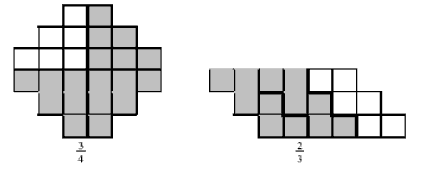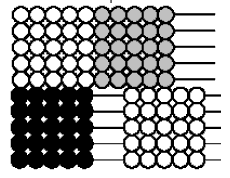Find fractions of regions.
Number Framework Stage 6
Scissors
Using Materials
Provide the students with a four-by-four square of paper. Tell them to divide the square in half so that each part has the same size and shape. Challenge them to come up with four other ways to cut the same square in half.
Share the methods. Ask them what the methods all have in common. Most of the paths cutting the square are likely to have rotational symmetry about the centre of the square. The students need to understand that different cuts can be classified as identical, for example, diagonals.

Ask the students what checks there could be to make sure that each of these ways of cutting results in two exact halves.
Focus the discussion on the fact that the two pieces map onto each other by reflection and/or rotation and are therefore of similar shape and size.
Discuss the idea that the square could be cut into two pieces that have the same area but different shapes. Choose an irregular half of the square and ask the students what the area of the shape will be in unit squares (eight, since that is one-half of 16).
Challenge the students to work out the area of quarters for the 16-unit square. They will probably use addition-based strategies like 8 + 8 = 16, so eight is one-half; 4 + 4 = 8, so four is one-quarter.
Provide other examples of finding fractions of blocks. Vary the symmetry to simplify the problems. Each block can be made with square tiles, and the tiles can be dealt into equal sets.

Provide some blocks made from squares and require the students to divide them into given fractions where use of symmetry might be advantageous. For example:
Using Imaging
Prediction: Allow the students to see and build the blocks shown below but ask them to visualise how they will cut them into the required fraction. Have them describe their cutting to a partner to develop geometric vocabulary. For example:
Focus the students on using multiplication rather than addition strategies. For example, to find 1/6 of the 18-unit square shape, the students might divide 18 by six. Record the answers using equations such as 3/8 of 32 is 12 ( 3/8 x 32 = 12).
Using Number Properties
Increase the number size while staying with fractions like halves, quarters, fifths, sixths, eighths, and tenths that make symmetrical partitioning effective. Provide examples that easily suggest the representation of the number as an array of square tiles. One hundred is of particular significance owing to its link with decimals and percentages. Such examples are easily modelled on the Slavonic abacus.
For example: To find three-quarters of 100 …
Other problems to pose:
2/5 of 25, 1/4of 80, 3/4 of 40, 2/5 of 100, 3/4 of 100 1/3 of 30


